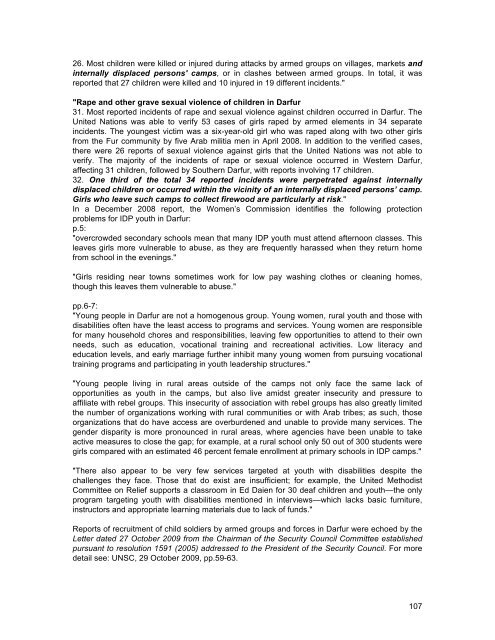SUDAN: Durable solutions elusive as southern IDPs return and ...
SUDAN: Durable solutions elusive as southern IDPs return and ...
SUDAN: Durable solutions elusive as southern IDPs return and ...
You also want an ePaper? Increase the reach of your titles
YUMPU automatically turns print PDFs into web optimized ePapers that Google loves.
26. Most children were killed or injured during attacks by armed groups on villages, markets <strong>and</strong><br />
internally displaced persons' camps, or in cl<strong>as</strong>hes between armed groups. In total, it w<strong>as</strong><br />
reported that 27 children were killed <strong>and</strong> 10 injured in 19 different incidents."<br />
"Rape <strong>and</strong> other grave sexual violence of children in Darfur<br />
31. Most reported incidents of rape <strong>and</strong> sexual violence against children occurred in Darfur. The<br />
United Nations w<strong>as</strong> able to verify 53 c<strong>as</strong>es of girls raped by armed elements in 34 separate<br />
incidents. The youngest victim w<strong>as</strong> a six-year-old girl who w<strong>as</strong> raped along with two other girls<br />
from the Fur community by five Arab militia men in April 2008. In addition to the verified c<strong>as</strong>es,<br />
there were 26 reports of sexual violence against girls that the United Nations w<strong>as</strong> not able to<br />
verify. The majority of the incidents of rape or sexual violence occurred in Western Darfur,<br />
affecting 31 children, followed by Southern Darfur, with reports involving 17 children.<br />
32. One third of the total 34 reported incidents were perpetrated against internally<br />
displaced children or occurred within the vicinity of an internally displaced persons’ camp.<br />
Girls who leave such camps to collect firewood are particularly at risk."<br />
In a December 2008 report, the Women’s Commission identifies the following protection<br />
problems for IDP youth in Darfur:<br />
p.5:<br />
"overcrowded secondary schools mean that many IDP youth must attend afternoon cl<strong>as</strong>ses. This<br />
leaves girls more vulnerable to abuse, <strong>as</strong> they are frequently har<strong>as</strong>sed when they <strong>return</strong> home<br />
from school in the evenings."<br />
"Girls residing near towns sometimes work for low pay w<strong>as</strong>hing clothes or cleaning homes,<br />
though this leaves them vulnerable to abuse."<br />
pp.6-7:<br />
"Young people in Darfur are not a homogenous group. Young women, rural youth <strong>and</strong> those with<br />
disabilities often have the le<strong>as</strong>t access to programs <strong>and</strong> services. Young women are responsible<br />
for many household chores <strong>and</strong> responsibilities, leaving few opportunities to attend to their own<br />
needs, such <strong>as</strong> education, vocational training <strong>and</strong> recreational activities. Low literacy <strong>and</strong><br />
education levels, <strong>and</strong> early marriage further inhibit many young women from pursuing vocational<br />
training programs <strong>and</strong> participating in youth leadership structures."<br />
"Young people living in rural are<strong>as</strong> outside of the camps not only face the same lack of<br />
opportunities <strong>as</strong> youth in the camps, but also live amidst greater insecurity <strong>and</strong> pressure to<br />
affiliate with rebel groups. This insecurity of <strong>as</strong>sociation with rebel groups h<strong>as</strong> also greatly limited<br />
the number of organizations working with rural communities or with Arab tribes; <strong>as</strong> such, those<br />
organizations that do have access are overburdened <strong>and</strong> unable to provide many services. The<br />
gender disparity is more pronounced in rural are<strong>as</strong>, where agencies have been unable to take<br />
active me<strong>as</strong>ures to close the gap; for example, at a rural school only 50 out of 300 students were<br />
girls compared with an estimated 46 percent female enrollment at primary schools in IDP camps."<br />
"There also appear to be very few services targeted at youth with disabilities despite the<br />
challenges they face. Those that do exist are insufficient; for example, the United Methodist<br />
Committee on Relief supports a cl<strong>as</strong>sroom in Ed Daien for 30 deaf children <strong>and</strong> youth—the only<br />
program targeting youth with disabilities mentioned in interviews—which lacks b<strong>as</strong>ic furniture,<br />
instructors <strong>and</strong> appropriate learning materials due to lack of funds."<br />
Reports of recruitment of child soldiers by armed groups <strong>and</strong> forces in Darfur were echoed by the<br />
Letter dated 27 October 2009 from the Chairman of the Security Council Committee established<br />
pursuant to resolution 1591 (2005) addressed to the President of the Security Council. For more<br />
detail see: UNSC, 29 October 2009, pp.59-63.<br />
107
















